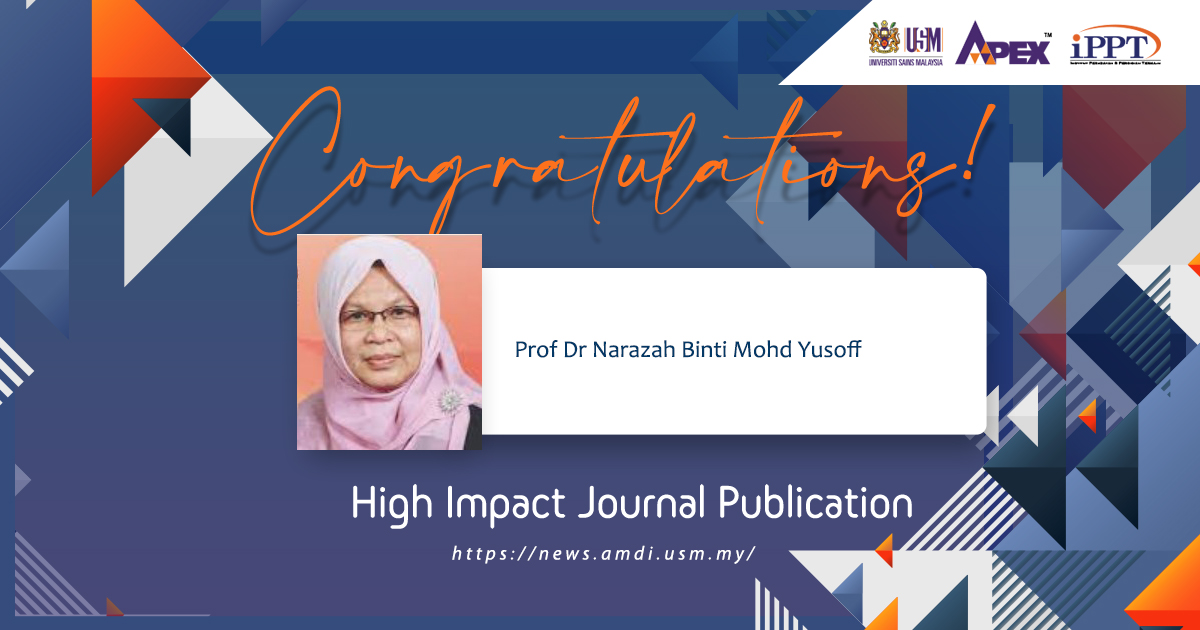
Prof Dr Narazah Binti Mohd Yusoff


Authors : Bin Hashim Halim-Fikri, Carsten W. Lederer, Atif Amin Baig, Siti Nor Assyuhada Mat-Ghani,
Sharifah-Nany Rahayu-Karmilla Syed-Hassan, Wardah Yusof, Diana Abdul Rashid,
Nurul Fatihah Azman, Suthat Fucharoen, Ramdan Panigoro, Catherine Lynn T. Silao, Vip Viprakasit,
Norunaluwar Jalil, Norafiza Mohd Yasin, Rosnah Bahar, Veena Selvaratnam, Norsarwany Mohamad,
Nik Norliza Nik Hassan, Ezalia Esa, Amanda Krause, Helen Robinson, Julia Hasler,
Coralea Stephanou, Raja-Zahratul-Azma Raja-Sabudin, Jacques Elion, Ghada El-Kamah,
Domenico Coviello, Narazah Yusoff, Zarina Abdul Latiff, Chris Arnold, John Burn,
Petros Kountouris, Marina Kleanthou, Raj Ramesar, Bin Alwi Zilfalil, and on behalf of the Global Globin Network (GGN)
Title of Publication : Global Globin Network Consensus Paper: Classification and Stratified Roadmaps for Improved Thalassaemia Care and Prevention in 32 Countries
Journal Name : Journal of Personalized Medicine
Quartile : Q1
Impact Factor : 4.945
Link : https://mdpi-res.com/d_attachment/jpm/jpm-12-00552/article_deploy/jpm-12-00552-v2.pdf?version=1649381540
Description : The Global Globin Network (GGN) is a project-wide initiative of the
Human Variome/Global Variome Project (HVP) focusing on
haemoglobinopathies to build the capacity for genomic diagnosis,
clinical services, and research in low- and middle-income countries. At
present, there is no framework to evaluate the improvement of care,
treatment, and prevention of thalassaemia and other haemoglobinopathies
globally, despite thalassaemia being one of the most common monogenic
diseases worldwide. Here, we propose a universally applicable system for
evaluating and grouping countries based on qualitative indicators
according to the quality of care, treatment, and prevention of
haemoglobinopathies. We also apply this system to GGN countries as proof
of principle. To this end, qualitative indicators were extracted from
the IthaMaps database of the ITHANET portal, which allowed four groups
of countries (A, B, C, and D) to be defined based on major qualitative
indicators, supported by minor qualitative indicators for countries with
limited resource settings and by the overall haemoglobinopathy carrier
frequency for the target countries of immigration. The proposed rubrics
and accumulative scores will help analyse the performance and
improvement of care, treatment, and prevention of haemoglobinopathies in
the GGN and beyond. Our proposed criteria complement future data
collection from GGN countries to help monitor the quality of services
for haemoglobinopathies, provide ongoing estimates for services and
epidemiology in GGN countries, and note the contribution of the GGN to a
local and global reduction of disease burden.